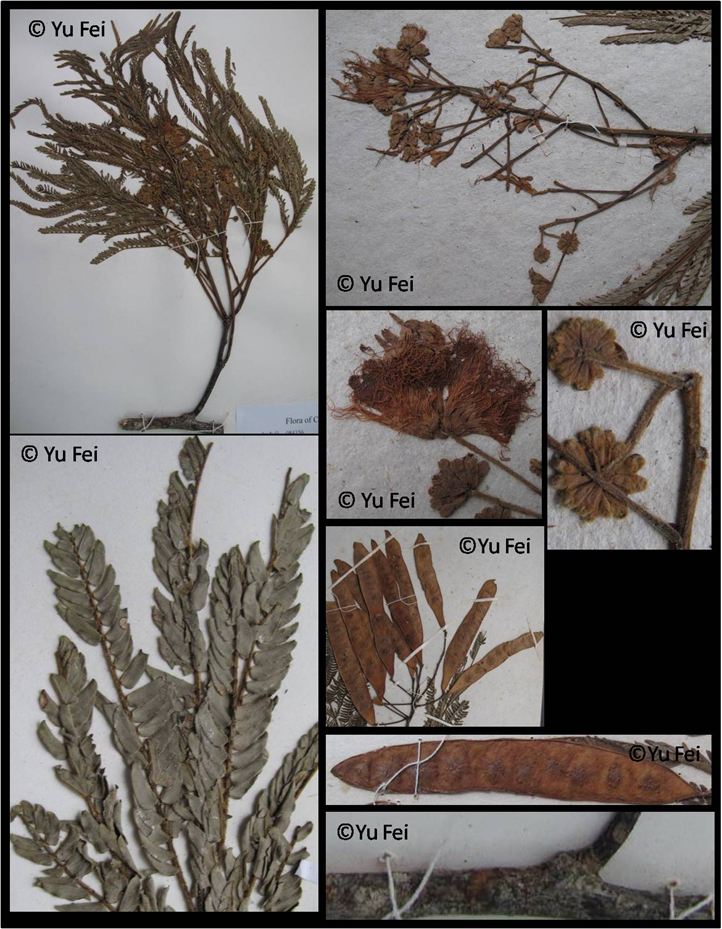Albizia chinensis (Osbeck) Merr., Amer.J.Bot. 3:575 (1826)
Latin for 'from China'.Synonyms
Acacia lomatocarpa Dc.
Acacia stipulata DC.
Albizia marginata (Lam) Merr.
Albizia stipulata (DC.) Boivin
Albizia stipulata B.Boivin
Arthrosprion stipulatum (DC.) Hassk.
Inga purpurascens Hassk.
Mimosa chinensis Osbeck
Mimosa marginata Lam.
Mimosa smithiana Roxb.
Mimosa stipulacea Roxb.
Pithecellobium serronii Glaz.
Description
Tree to 30(-43) m high, d.b.h. to 70(-140) cm. Tree with umbellate crown. Bark
smooth, grey, living bark red; sapwood white; heartwood brown. Branchlets slightly angular
in the distal parts, terete, puberulous to tomentose, glabrescent. Stipules auriculate, c.
1-1.5 by 0.6-3 cm, usually visible in young branches and inflorescence, caducous. Leaves: rachis 10-25 cm,
puberulous to tomentose, a gland c. 1.5-2 cm above the base, elliptic(-suburceolate), raised, c. 2-3 by
1-1.5 mm; pinnae 4-14 pairs, 4-14 cm, puberulous to tomentose, glabrescent, with glands at the junctions
of the 1 or 2 distal pair(s) of leaflets, narrowly elliptic to slit-like, concave, c. 1 mm, or glands
absent; leaflets (10-)20-31 pairs per pinna, opposite, sessile, thinly chartaceous; asymmetrically
subulate, 6.5-10 by 1.5-3 mm, base truncate, apex sharply acute, at both sides sparsely sericeous
or glabrous; main vein and margins sericeous to tomentose, main vein forming the front margin.
Inflorescences consisting of pedunculate glomerules aggregated into terminal yellowish-green tomentose
to hirsute panicles; peduncles up to 5 in clusters, often with auriculate stipules at the base, 1-3 cm
long, bearing glomerules of 10-20 sessile or subsessile flowers. Flowers dimorphic, bisexual, pentamerous.
Calyx tubular to narrowly campanulate, tomentose to hirsute, (2-)2.5-5 mm, teeth triangular,
acute, 0.3 mm. Corolla funnel-shaped, puberulous to hirsute especially on the lobes, 6-10
mm, lobes triangular-ovate, acute, 2-2.5 mm. Stamens white at base, yellowish green at top,
c. 20 mm, tube as long as to slightly longer than the corolla tube. Ovary glabrous, c. 3 mm, sessile.
Pod yellowish-brownish, flat, straight, often with slightly sinuate margins, indehiscent or irregularly
breaking up, 9-15 by 1.8-2 cm, valves rigidly chartaceous, glabrous, veins inconspicuous. Seeds
elliptic, flattened, c. 7 by 4-5 by 0.5-1 mm; areole at the micropylar end, subcircular, c. 1 mm
in diameter, open towards the hilum, pleurogram not parallel to the margin of the seed. [from Flora
Malesiana]
Ecology
Native of mixed deciduous forest and rain forest in humid tropical and subtropical monsoon climates
with annual rainfall varying from 1000-5000 mm. It occurs in secondary forest, along river banks, and
in savannas up to 1800 m altitude. Light frost is tolerated. It is adapted to poor soils, high pH, is
fairly salt-tolerant and thrives on lateritic alluvial soil and sandy mining areas. In growth trials
on poorly drained, infertile, gleyed, podzolic soils it had a survival rate of nearly 100%.
Uses
Commonly used as a shade tree in tea and coffee plantations, often in a mixture with other trees like
Paraserianthes falcataria (L.) Nielsen and Erythrina spp. In China shade-tolerant herbs
are sometimes planted under Albizia chinensis. It is planted for slope stabilization and soil
improvement. In parks and gardens and along roads it is grown as an ornamental. The tree has shown
some potential as a fodder: the leaves are readily eaten by goats but the bark of branchlets is hardly
touched, possibly because of its high saponin content. Due to the light weight of its wood, timber use
is limited to house building, light furniture, tea chests and veneers. In India, it is used in boat
building. As a firewood it is of low quality.
Distribution
Occurs naturally in India, Burma (Myanmar), Thailand, Indo-China, southern China, Java and the Lesser
Sunda Islands (Bali and Nusa Tenggara). In Borneo and Sumatra, it is possibly only found in cultivation.
It is cultivated in many tropical countries.
Local names
Cambodia: kool.
China: Yingshu.
English: Silk tree, Chinese albizia.
Indonesia: jeungjing (Sundanese), sengon (Javanese), keura (Eastern Sumba).
Laos: kha:ng (Xieng Khouang), kha:ng hu: (Vientiane).
Thailand: kang luang, san-kham (Northern), khang hung (Khon Kaen).
Vietnam: s[oos]ng r[aws]n t[af]u, cham (Ha Tuy¨ºn), chu m[ef] (Quang Ninh).
